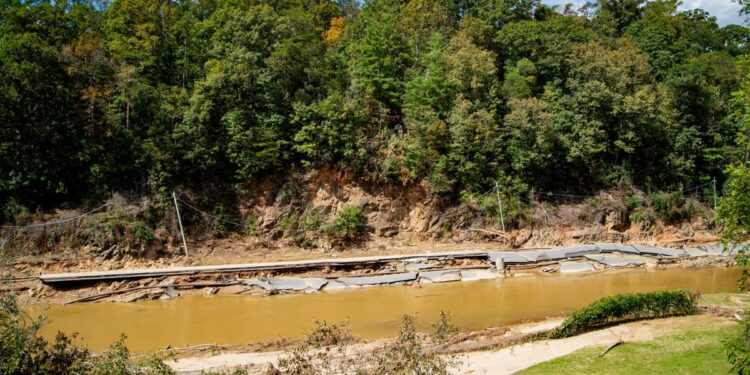Assessing the Ecological Impact of Tropical Storm Helene in Western North Carolina
The aftermath of Tropical Storm Helene has had a profound effect on both human communities and the natural landscapes of Southern Appalachia. As experts navigate damaged regions, especially in Western North Carolina, they face challenges not only to their research but also to their personal lives. Initial evaluations suggest that certain ecosystems may need decades to fully recover from this unprecedented storm.
The Long-term Consequences for Aquatic Habitats
One stark example of ecological loss is evident at the Armstrong State Fish Hatchery located in McDowell County, where flooding caused by Helene led to the unfortunate demise of all 600,000 fish under care. This data comes from officials at the North Carolina Wildlife Resources Commission (NCWRC), who reported that all aquatic life was lost due to either escape or death during this environmental crisis.
The violent currents shifted substantial amounts of sediment into water bodies—changes which are particularly detrimental to aquatic habitats sensitive to variations in turbidity. Falyn Owens, a wildlife extension biologist with NCWRC, noted that long-lasting repercussions will predominantly affect fish and other water-dwelling organisms: “The threat posed by debris entering these sensitive areas could lead to serious water quality problems lasting for months.”
Miranda Turner, another wildlife health biologist with NCWRC, emphasized that the extent of these issues will largely depend on what types of toxic materials were swept into these vital habitats during the storm. The implications for fish populations as well as amphibians and reptiles are likely severe.
Impact on Terrestrial Species
While terrestrial animals such as deer and raccoons generally have more mobility compared with aquatic life forms—and therefore might evade some immediate consequences—Owens expressed concerns about casualties among various species unable to escape rising waters. Despite potential loss among individuals within those species groups, large-scale population impacts are not anticipated.
A notable observation pertains to migratory birds; several coastal bird species were tracked moving inland following Helene’s passage—even reaching locations like Indiana. Data compiled by BirdCast showcased reports from enthusiasts spotting laughing gulls near Asheville during this period—a clear testament to how storms can alter avian patterns significantly.
The Uncertainty Surrounding At-Risk Species
The fate of numerous vulnerable species remains ambiguous post-Helene; among them are federally endangered gray bats and multiple salamander varieties endemic to the region. Numerous roosts under bridges—a habitat badly damaged due reduced structural integrity—pose additional risk factors that require time for thorough evaluation before recovery strategies can be established.
A Look Ahead: Climate Change Compounding Challenges
This incident unfolds against a troubling backdrop; as climate change escalates extreme weather events’ severity and frequency will likely amplify wildlife crises further through disease proliferation and habitat displacement—a point emphasized by Turner regarding potential future scenarios confronting local biodiversity efforts.
Biodiversity under Threat: Vegetation Changes and Agricultural Damage
Tropical Storm Helene left many regions stripped bare—a phenomenon proving advantageous for invasive plant varieties aiming capitalize on disturbances within ecosystems previously dominated by native flora. “Restoring biodiversity while controlling invasive growth will prove critical,” remarked Owens about coming challenges tied directly to recovery initiatives for scalable vegetation effective across disturbed environments.
Agriculture too bore significant losses resulting from excessive rainfall impacting thousands upon crops valued over $600 million—according recent assessments published by American Farm Bureau—that detailed favorable conditions promoting bacterial infections afflicting vegetable cultivations swamped following floods beaten commodities unsellable according federal guidelines depriving farmers crucial income prospects amid ongoing adjustments needed rebuilding effort underway across affected agriculture sectors trembling beneath shifts yet unfold behind Hurricane Helene’s wake…
Outlook: Advancing Towards Recovery
No ecological rehabilitation can occur overnight; particularly damaged zones may take decades before returning resilience observed pre-Hurricane Helene arrival mentioned earlier targeting specific biodiverse populations often slowest regrowth adaptation cycles affect entire regions recovering systemically necessitating collaborative multidisciplinary approaches forge paths forward collectively enlisted empower efforts toward restoring restorative balance horizons bleak seized hold glimpsed just beyond surface incrementally advancing incremental motions address burgeoning restore resiliency awaiting return gradual full potential abated once obstacles transcended needed accumulate harmony new indigenous heights unfold embrace flourishing hopes…










